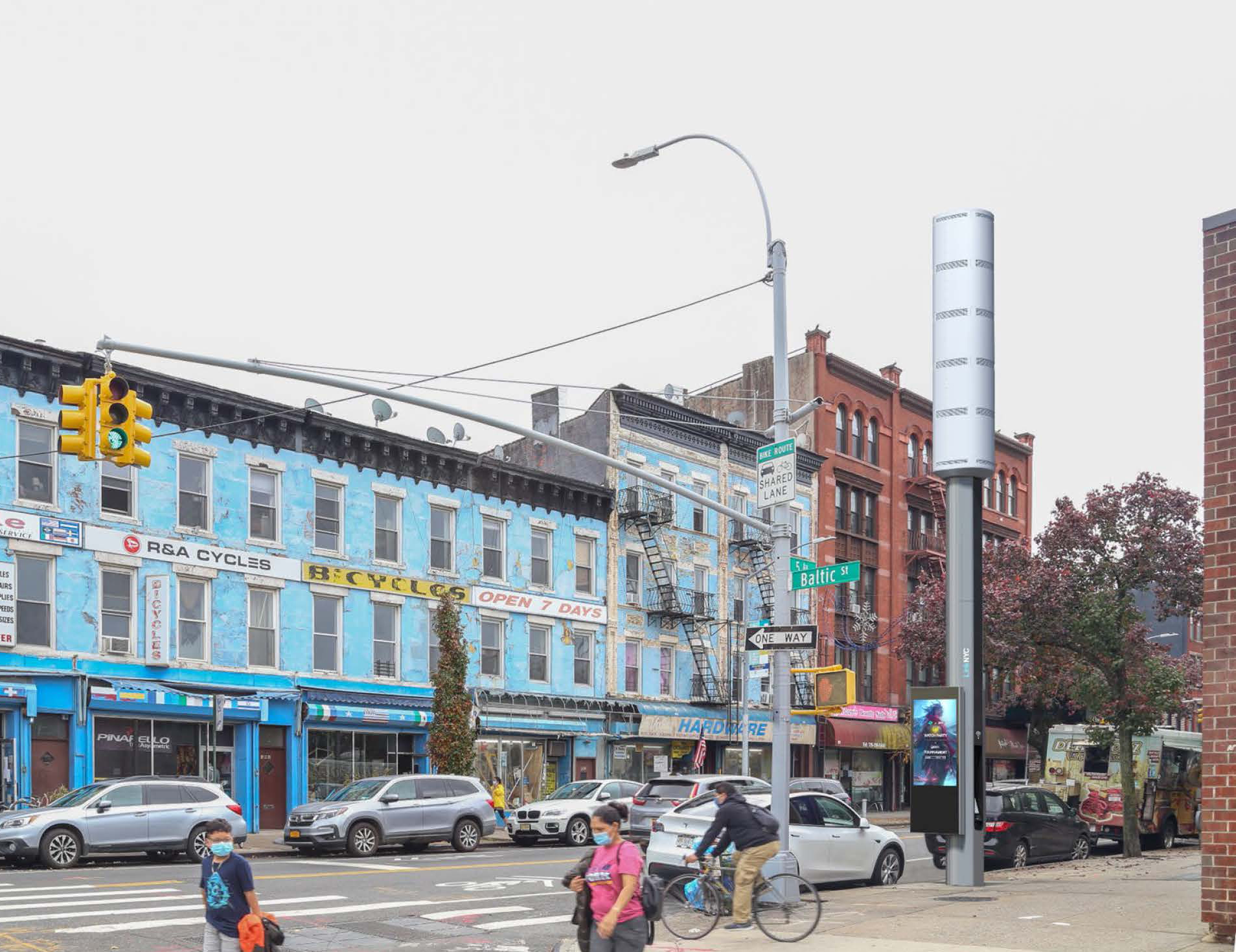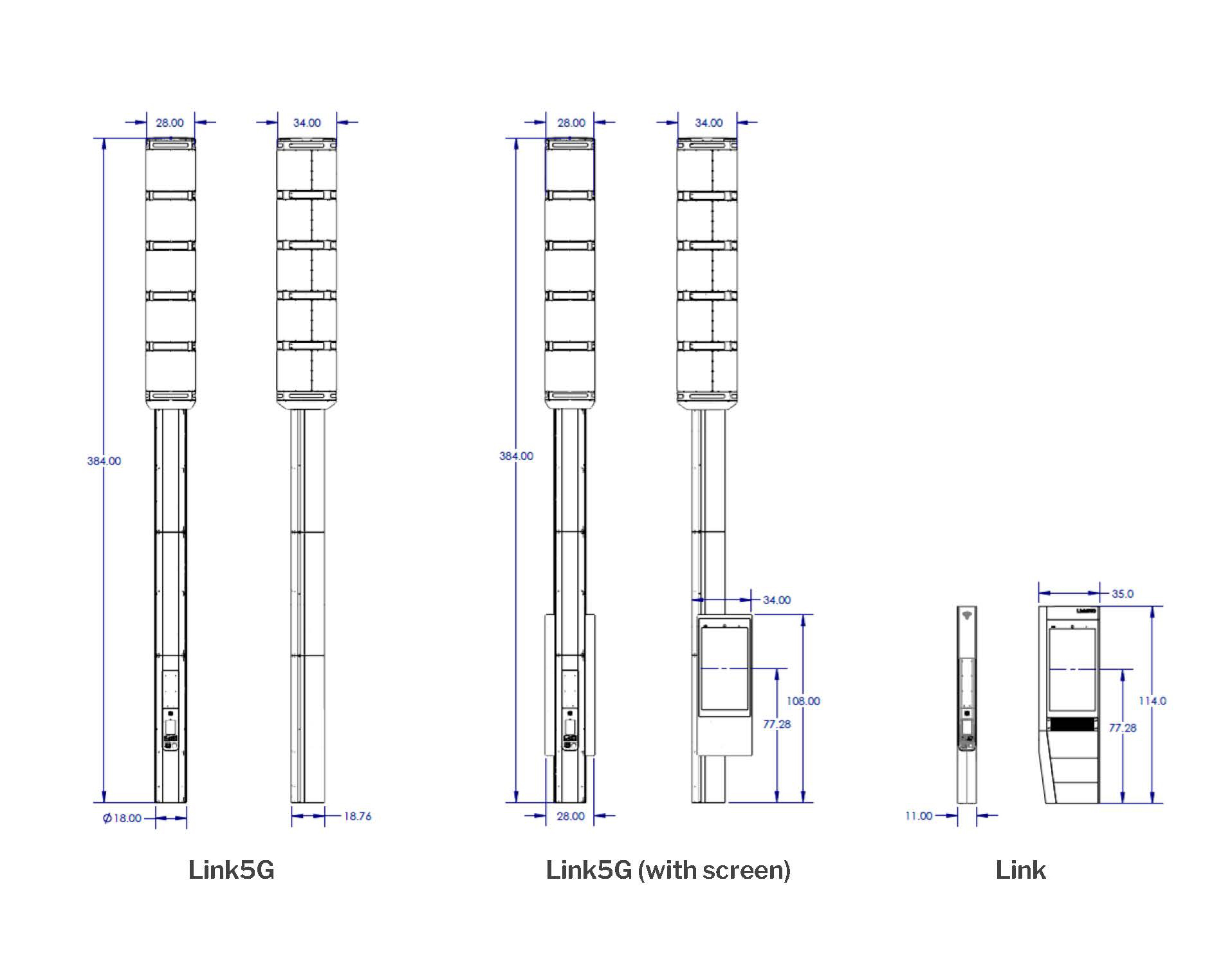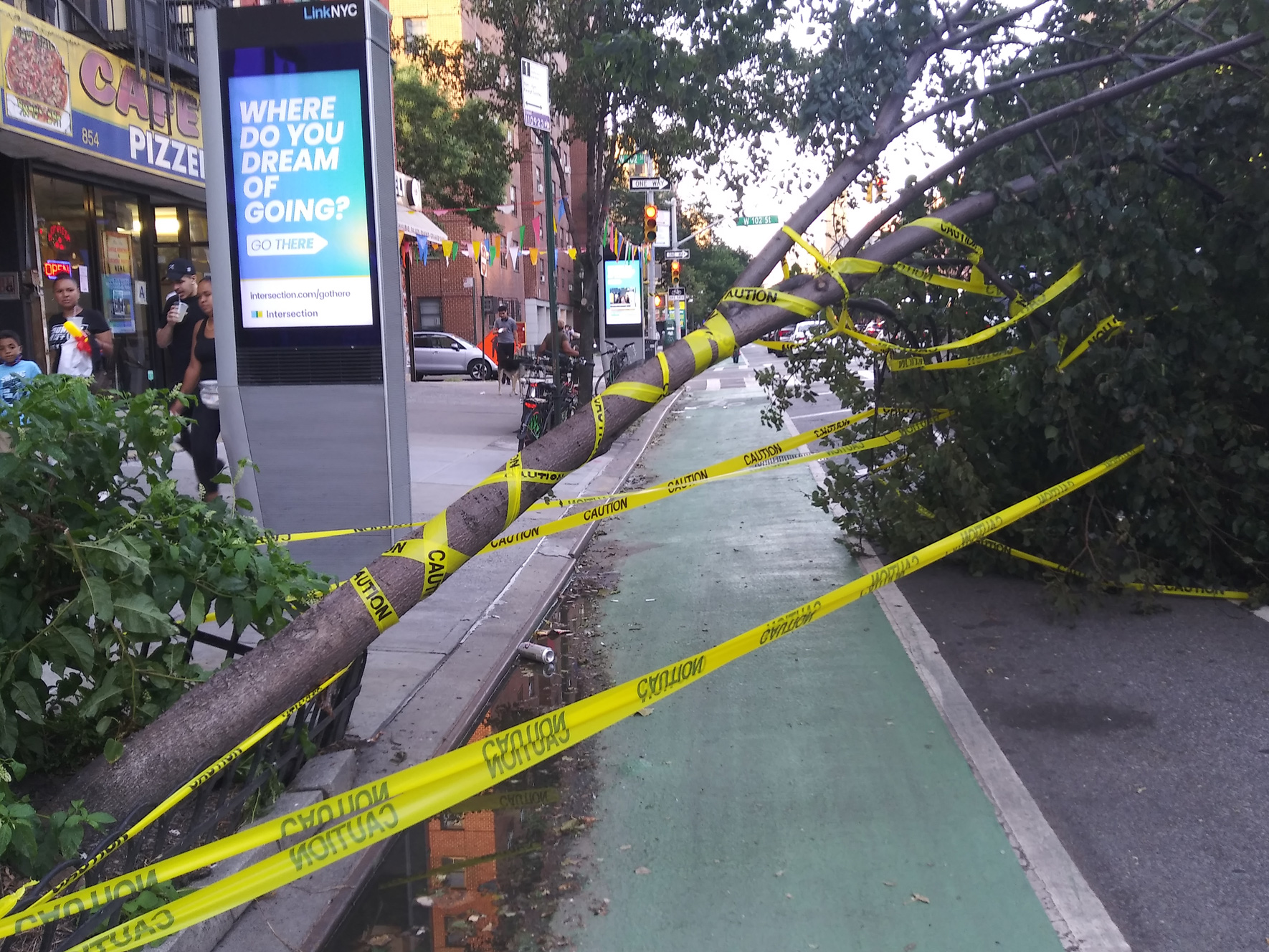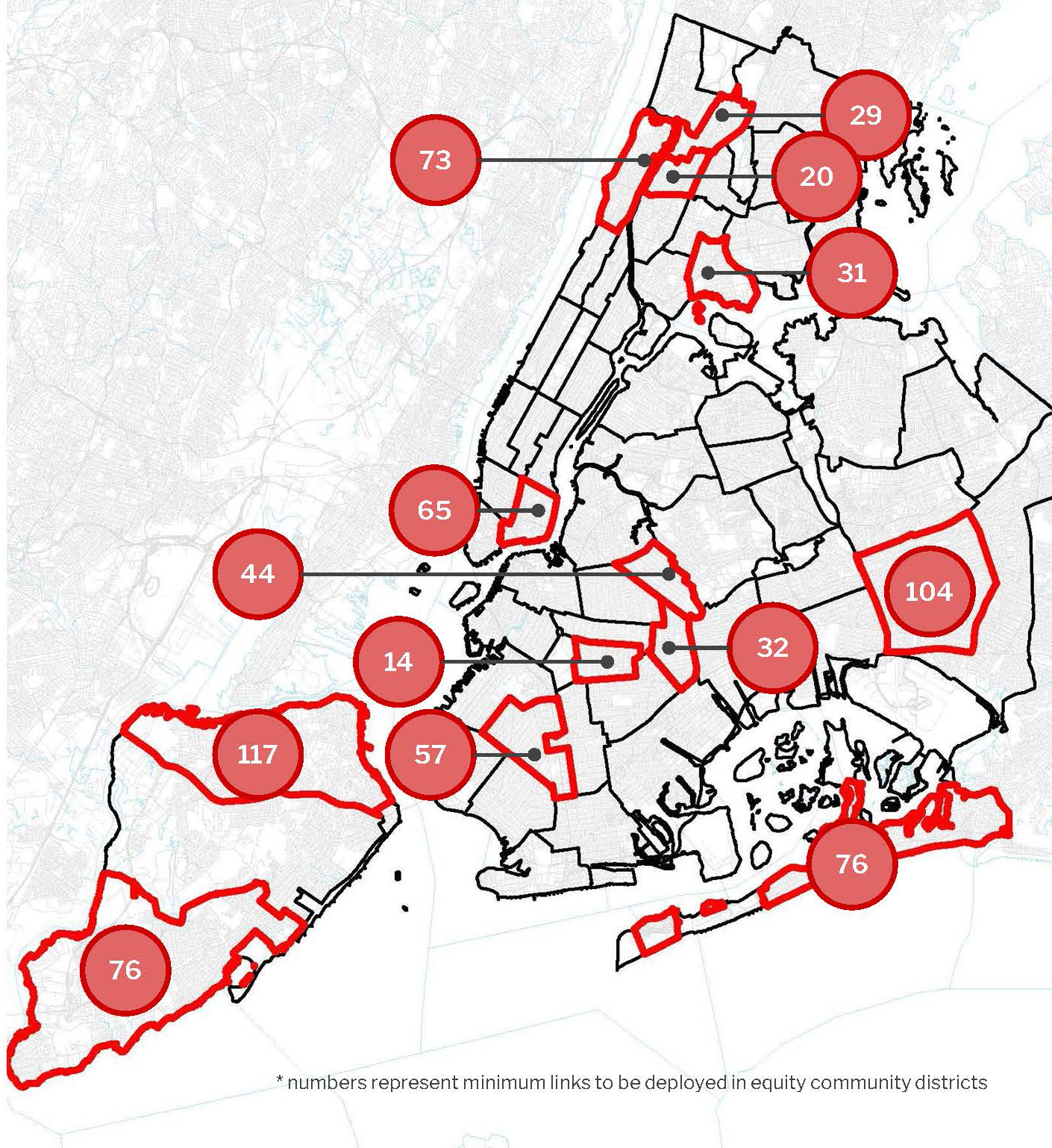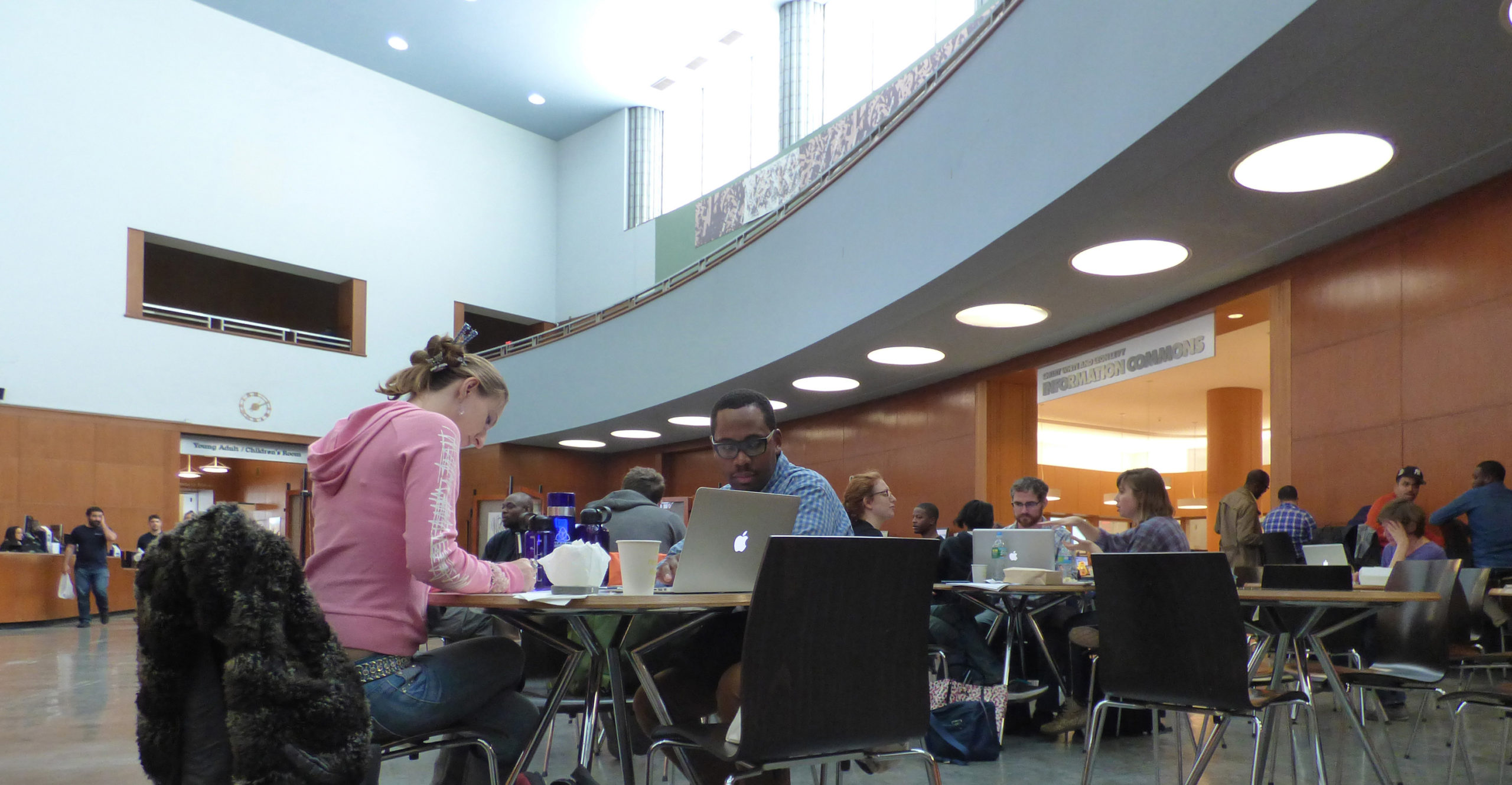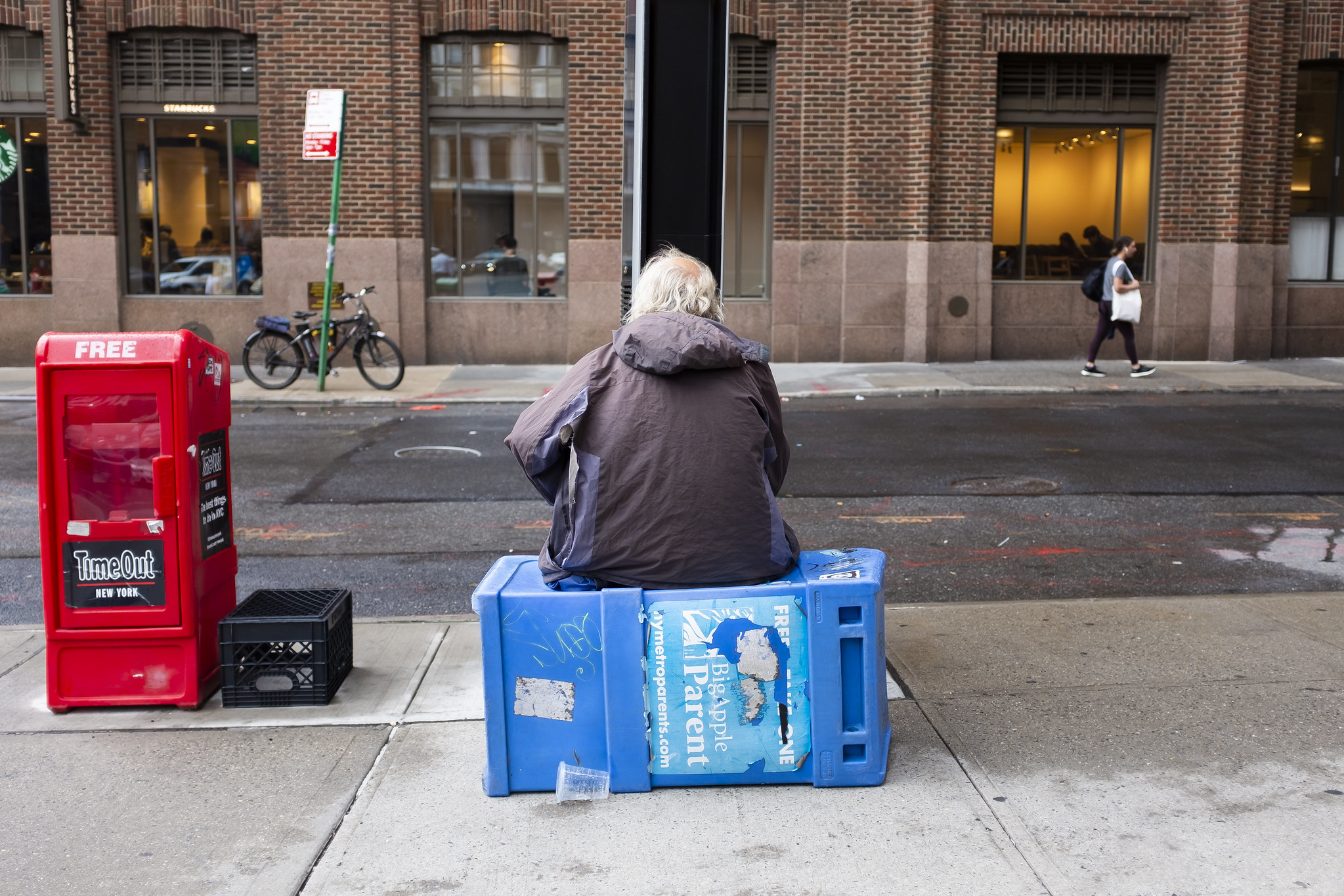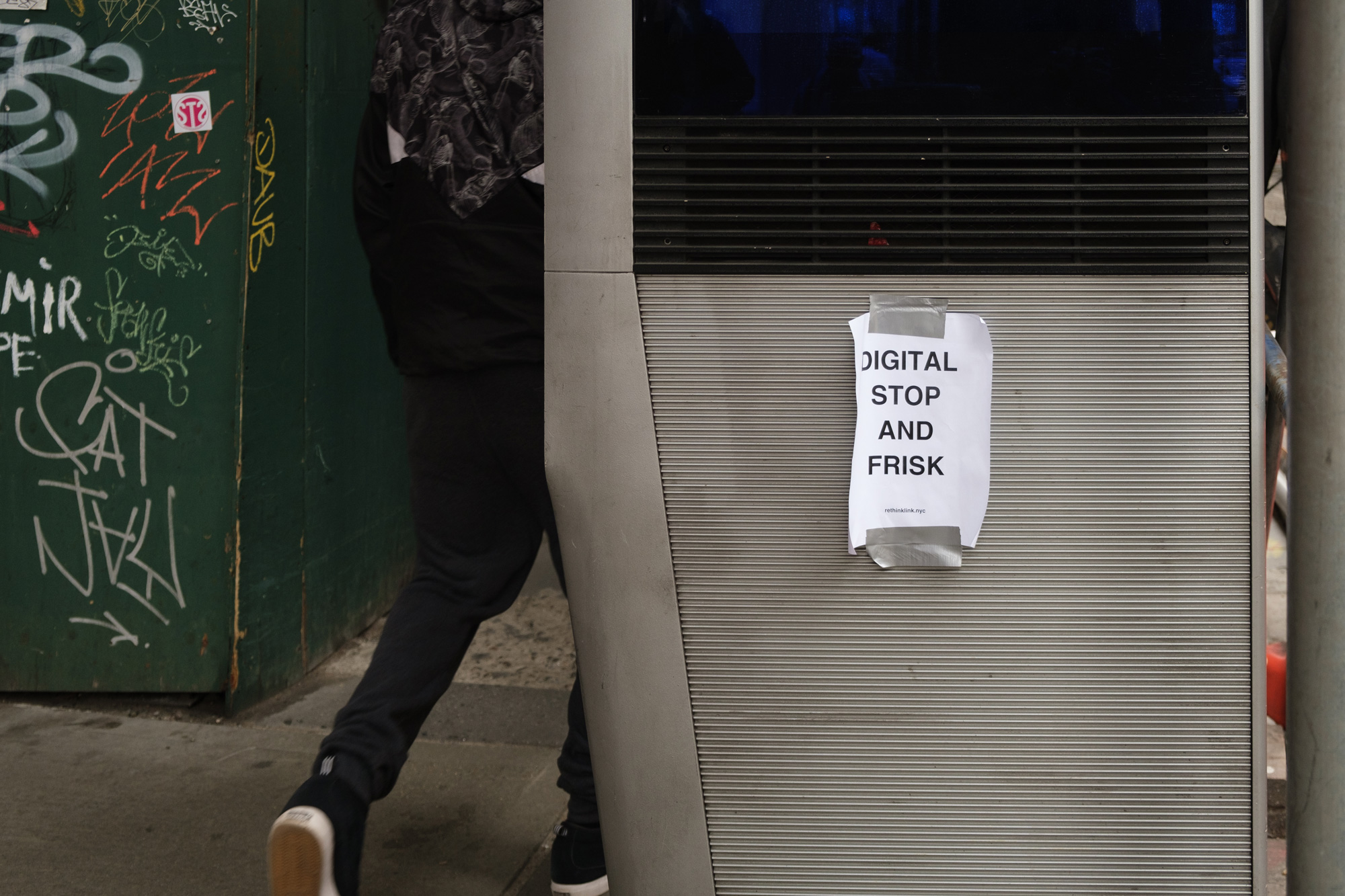
We are celebrating 15 years — and counting — of stories that are deeply researched and deeply felt, that build a historical record of what the city has been.
We are celebrating 15 years — and counting — of stories that are deeply researched and deeply felt, that build a historical record of what the city has been.
What ever happened to LinkNYC? After a series of ups and downs, followed by a period of dormancy and near obsolescence, those slim, silver-and-black kiosks are poised to come back in a big way — and by big, we mean towering. Doubling down on its initial promise to “bridge the digital divide,” the consortium behind the so-called “largest, fastest municipal Wi-Fi system in the world” is looking to tell a tale of redemption. But there’s always more to the story, isn’t there? To dig deeper, we partnered with one of our favorite local newsrooms, THE CITY, who have long been keeping an eagle eye on what happens when city policies hit the ground. Just last month, they spotted a lone, early version of a so-called Link5G “smart pole” in Long Island City. Hundreds of similar structures are about to be rolled out across the boroughs, concentrated in areas with limited digital access, and offering next-generation cellular service alongside Wi-Fi and other familiar LinkNYC features. Below, THE CITY’s Gabriel Sandoval and UO’s Joshua McWhirter look even closer at the complex trajectory of the Link program over the years, and what these new Link5G towers might means for the city’s increasingly digital future — especially for those New Yorkers who have long been struggling to keep connected.
This article was published in partnership with THE CITY, a nonprofit, nonpartisan digital news platform dedicated to hard-hitting reporting that serves the people of New York.
During a panel at a March tech summit in lower Manhattan, the CEO of CityBridge told attendees the pandemic exposed a stark “digital divide” across the five boroughs. “It did really lay bare the sort of haves and have nots when it comes to digital technology,” explained Nick Colvin, whose tech consortium runs LinkNYC, the multi-use Wi-Fi and advertising kiosks, and Link5G, the forthcoming, supertall poles that add 5G signal transmission power.
What he didn’t tell the audience was that CityBridge largely failed to accomplish its goal of helping to bridge the digital divide in the six years after kiosk installation began. The company put the majority of its more than 1,800 LinkNYC units in Manhattan but relatively few in the Bronx, Brooklyn, Queens and Staten Island, where neighborhoods lack at-home and mobile broadband at a higher rate. As THE CITY, the state comptroller and other news outlets have documented, the company fell short of ad revenue projections and was unable to pay $60 million it owed the city. The revenue shortfall resulted in an abrupt halt to kiosk installation, leaving many areas outside Manhattan without the access they were promised. The company faced bankruptcy in 2019. The city contemplated terminating the deal in 2020.
But despite the LinkNYC program’s history of delinquency, city officials are giving CityBridge another chance to bolster digital equity citywide: The company is now preparing to install hundreds of 32-foot-tall Link5G towers, beginning this summer. The city’s Public Design Commission approved the Link5G design for commercial and manufacturing areas at a meeting in December. Members postponed a vote on a residential rollout in order to review data on the service and infrastructural impacts of the towers’ first wave.
The new structures will be more than three times as tall as the original LinkNYC design. Like their predecessors, the lower part of the new structures will have a 911 button, USB ports, a tablet, calling capabilities and advertising displays. The structures will also provide free Wi-Fi. But the new designs will be topped by fifth-generation cellular network technology, or 5G, which will radiate from their upper chambers to enabled devices at street level. Multiple telecom companies could pay CityBridge to house their 5G equipment inside the chambers of a single structure. Their payments would bring in a new revenue stream to CityBridge, funding the company’s operations and expanded footprint.
The structures’ signals will supplement existing 5G networks that currently provide consumers speedy wireless internet service. City officials and CityBridge insist that more cell sites are necessary given the technical specifications of 5G, which require a “line of sight” to work: 5G is carried on millimeter waves that, unlike 4G frequencies, cannot penetrate most surfaces, whether a building or a bus.
Citing a statistic from the New York City Internet Master Plan that nearly “40 percent of New York City households lack the combination of home and mobile broadband, including 18 percent of residents — more than 1.5 million people — who lack both,” CityBridge, along with the city’s Department of Information Technology and Telecommunications, have asserted that expanded 5G wireless service, paired with an “equitable deployment mandate,” will provide a crucial public benefit to underserved communities.
Yet why did the city salvage its franchise agreement with a company that could not deliver on its promises in the first place? The original Link kiosks were built atop a dated and obsolete network of public payphones that CityBridge continues to dismantle; now the city faces the prospect of making sure that what it has long called the “largest, fastest municipal Wi-Fi system in the world” doesn’t itself become a stranded asset. Beyond questions of whether or not the city can keep up in a rapidly changing landscape of technological products and innovation, can it make sure that its most under-resourced populations don’t get left behind, again?
In 2014, CityBridge signed an agreement with the de Blasio administration, requiring the company to install at least 7,500 kiosks, while aiming for a lofty goal of 10,000. The company also committed to provide $500 million from ad revenue to the city’s coffers over twelve years — but fell well short. Maya Wiley, counsel to former Mayor Bill de Blasio at the time of LinkNYC’s launch in 2016, has taken credit for helping to negotiate the deal. Wiley, a former mayoral candidate, declined to comment through a spokesperson.
Under an amendment to the deal signed last year, CityBridge is now required to install and activate “no fewer than 4,000” structures by 2026. With the City’s approval, the company could eventually install 3,500 more than the required amount. “Over the next five years, we’re deploying a little over 2,000 more structures, at the minimum,” Colvin told the crowd at the daylong City & State summit last month.
The deal gives CityBridge the power to convert the original kiosks to 20-foot-tall “retrofitted” 5G poles, or replace them completely with the 32-foot model, with or without the digital advertising screens that LinkNYC has become known for. The amendment also marked a major shift in CityBridge’s business model. Instead of relying on revenue from ad sales, the company is poised to see earnings from renting space inside the poles to telecom companies such as AT&T, Verizon and T-Mobile, which would complement their existing 5G infrastructure. Consumers would need a mobile data plan that includes 5G service for their devices to connect to that signal, though Wi-Fi will remain free.
“As with all 5G deployments, a user will need a 5G enabled device and plan to connect to the carriers’ 5G access point,” said Dan Levitan, a spokesperson for CityBridge. New Yorkers wouldn’t experience more robust connectivity through the Link5G structures without a device, but they would when they get one, Levitan said. “Over time, more and more New Yorkers will have 5G enabled phones, and it’s critical that 5G service reach all neighborhoods and communities,” he said. “5G service benefits all mobile network users by increasing capacity of the overall network.”
Levitan noted that 5G networks, currently consisting of carrier equipment on rooftops, light poles, and other “smart” infrastructure, require even more transmission points than 4G networks “because the signal delivers more capacity but travels a shorter distance.” “The challenge in a city like New York, is having enough available real estate to place carrier equipment,” Levitan said. “Without Link5G, the city would be limited to existing infrastructure that wasn’t designed to meet the specific needs of wireless technologies like 5G.” He added that Link5G’s modular design allows structures to have “power, fiber and enough room for all carriers deploying 4G, 5G and the other Gs of the future.”
“Link5G will be a badly needed additional option that carriers can leverage,” he continued.
A spokesperson for DoITT, which oversees the Link programs via the franchise agreement, also noted that the new tech would increase the power of existing 5G networks, while the multi-tenant design would reduce the oversaturation of carriers’ small cell sites on the streetscape. “The wireless carriers were consulted on the Link5G design to accommodate the kind of equipment that is needed now and for years to come,” said the DoITT spokesperson, Stacy Gardener. “These structures allow for the installation of small cells in a denser configuration, requiring fewer installation locations.”
The city is expected to receive 8 percent of gross revenue up to $200 million, plus an additional 50 percent on all revenue over $200 million, according to the new deal. DoITT officials acknowledge that CityBridge previously overestimated how much revenue would be generated through ad sales for LinkNYC kiosks. But representatives of both CityBridge and DoITT declined to provide an estimate of how much revenue would be generated by leasing space to telecom companies in the Link5G towers.
Between 2021 and 2030, the city expects to receive a minimum total of $87.5 million, Gardener said. It includes the $60 million owed and a minimum payment of $750,000 in 2021 and $3 million per year for 2022 through 2030. CityBridge paid $25 million of its debt to the city in June 2021, after the amendment’s approval.
Only time will tell if the company’s new business model becomes financially viable, an epic failure like the preceding advertising model, or something in between. One source from a telecom giant said their company doesn’t have confidence in CityBridge’s ability to complete the rollout of Link5G, predicting that the structures will “run into a buzzsaw” when people start to see them crop up in their communities. “I don’t think they’ll be able to scale it,” said the source, who asked to remain anonymous to speak freely about Link5G and the industry’s ambitions for 5G expansion.
The Link5G installations come as telecom companies like AT&T are ramping up deployment of small cell sites for 5G. A recent blog post by an AT&T executive explained that the company is “pushing the traditional options for how 5G is deployed” as it targets streetlights and other existing infrastructure. “Keeping pace means continued expansion and enhancement of the network, including more 5G small cell sites in areas where you live, work and play,” the post reads. The president for AT&T’s North Region echoed that sentiment. “In New York City, a robust 5G network will help fight the digital divide and boost our economy — which is why we are working with city government and beyond to explore every option to roll out more 5G nodes as quickly as possible,” said the president, Patricia Jacobs.
According to Shane Greenstein, an economist and professor at Harvard Business School, and author of How the Internet Became Commercial: Innovation, Privatization, and the Birth of a New Network, the financial incentives for expanding 5G networks are great in an industry that has seen explosive growth over the last decade. Citing U.S. Census data, Greenstein explained that total revenue from wireless data services has increased by roughly $5 billion each year since 2010.
The next generation of wireless connectivity could enable a slew of data-intensive applications and services to be used outside the home, from high-quality video streaming, to mobile, interactive gaming, to quick software updates for autonomous vehicles. However, the ultimate success of 5G will rely as much on developers and users as network expansion itself. “Until you see that app community come forward with imaginative new uses, that’s going to slow the deployment and usage. You’ve got to have the whole ecosystem move forward,” Greenstein said.
To make up for inequitable distribution in the past, CityBridge is required to install 90 percent of the new poles above 96th Street in Manhattan and in the Bronx, Brooklyn, Queens, and Staten Island, per the deal. Among the total of 4,000 structures required to be built, CityBridge is also required to install 739 in 13 so-called “equity” areas.
City officials picked the locations based on their substantial foot traffic, low median incomes, and lack of broadband options for local households. The areas include Hunts Point and Longwood in the Bronx; Bushwick, Brownsville, and Ocean Hill in Brooklyn; Inwood and Washington Heights in Manhattan; Rockaway, Jamaica, and Hollis in Queens; and Port Richmond, St. George, and Stapleton in Staten Island. As the City is prioritizing these areas for the installation of a private company’s money-making machines, other built environment shortcomings — including a lack of tree canopy, excessive illegal trash dumping and limited access to affordable, healthy food options — remain a detriment to the quality of life for local residents there.
Levitan said telecom companies need “suitable underlying power and fiber infrastructure” to support their 5G equipment, and that the equity areas “have typically lagged in such fiber infrastructure.” He declined to share any 5G network maps that may be in CityBridge’s possession and referred THE CITY to telecom companies for more information. “Link5G will expand fiber to these neighborhoods as well as provide additional locations to place 5G radio equipment,” Levitan said.
Gardener noted that the structures will provide the familiar menu of LinkNYC amenities, such as free Wi-Fi, USB ports, and calling capabilities. “Bringing all of these services to previously underserved areas was a top consideration,” she said. A spokesperson for CityBridge didn’t say where Link5G installations will begin first. One pole, in Long Island City, is already up for testing, THE CITY reported in March.
Their height would make for highly visible pieces of street furniture. Manhattan neighborhood preservation groups Landmark West! and Save Chelsea have already spoken out against what they view as an eyesore. Sean Khorsandi, executive director of Landmarks West! and a professor of design and architecture at the New York Institute of Technology, said CityBridge shouldn’t be rewarded for failing to distribute kiosks to low-income neighborhoods on its first try. But that’s exactly the message the city is signaling, he added: “‘Because you did such a poor job of it, you get this prize of an even bigger, uglier solution that now does something else.’ So, these were never meant to be 5G transponders.”
Nevertheless, investors are betting on CityBridge’s new model. ZenFi Networks, a digital infrastructure company based in the tri-state-area, is investing $200 million in CityBridge. The company will be the primary builder of Link5G, laying the fiber network infrastructure, according to DoITT. This network will extend into many parts of the city that currently lack fiber, potentially opening up high-speed broadband access to homes and businesses in underserved neighborhoods. ZenFi is no stranger to CityBridge. The company built the infrastructural framework for the LinkNYC program, its CEO, Ray LaChance, told Telecom Ramblings in 2017.
Walter Cannon, vice president for business development at ZenFi, cautioned that the rollout of Link5G isn’t the be-all-end-all solution to tech accessibility issues. “It’s like peeling the onion back, and this is just one of the layers on the outside,” he said. Cannon pointed to a partnership between CityBridge and Silicon Harlem, a digital equity organization in Upper Manhattan, on the creation of a “gigabit center.” Located at West 148th Street and Frederick Douglass Boulevard, the recently opened center offers community members a place where they can use computers and access the internet. A 2015 amendment to CityBridge’s original agreement required the company to establish a center in each of the five boroughs. A center for each of the other boroughs — The Bronx, Brooklyn, Queens and Staten Island — has yet to be established. A spokesperson for CityBridge declined to provide a status update on their development.
Still, LinkNYC skeptics say the program isn’t doing much overall to solve equity issues. Shannon Mattern, a professor of anthropology at The New School who has long studied libraries and media infrastructure, said that libraries have been more effective than LinkNYC at addressing digital inequity. She said libraries provide “the hardware, the software, that connectivity free of charge to anybody who wants to come in their doors or sit on the stoop outside for the Wi-Fi that leaks outside the building.” The city’s three library systems make 8,500 computer workstations available to the public and offer free Wi-Fi at every branch. Since 2015, they have also lent Wi-Fi hotspots to patrons.
Germaine Halegoua, a digital media scholar based at the University of Michigan, noted that bridging the digital divide will depend on more than just improvements to wireless technology. Despite 5G’s robust connection speeds, Halegoua explained, “If you don’t have a computer and you’re a cellphone-only user, and you’re trying to fill out a job application, or download your homework, it’s not going to help with the fact that you don’t have a device to do that. It’s not going to help with digital literacy.”
Controversy hasn’t always surrounded CityBridge. In late 2012, the Bloomberg administration announced a competition to “reinvent” the public payphone as the city’s franchise agreement with Titan — a private advertising firm with a monopoly on the city’s aging payphone network — was dwindling. Titan remained profitable through ad sales and contributed millions to the city’s coffers in the early 2000s, even as payphones suddenly became relics of a bygone era.
“The goal of Reinvent Payphones is to foster innovative, data and design-driven ideas that will help modernize payphone infrastructure across the five boroughs and optimize use of public space once the City’s current payphone contracts expire in 2014,” noted a press release on December 4, 2012, when more than 11,000 payphones stood citywide. Applications poured in for the competition, mostly from professional designers and architects, said Aaron Shapiro, an assistant professor of technology studies at the University of North Carolina at Chapel Hill, who detailed the contest in his book, Design, Control, Predict: Logistical Governance in the Smart City.
The competition dragged on, outlasting Mike Bloomberg’s final term in office. His successor, Bill de Blasio, inherited it when he was elected mayor in 2014. Under the de Blasio administration, the competition got a rebranding to match the new mayor’s campaign promises around reducing economic inequality, Shapiro said. The infrastructure project transformed into a vehicle to bridge the digital divide. DoITT changed request for proposals to say that any franchisee intending to sell ads would be required to provide Wi-Fi and USB outlets free of charge, he said.
Out of this contest emerged a winner, with a design of nearly ten-foot-tall kiosks with LED advertising displays. The original CityBridge consortium consisted of Control Group and Titan, along with Qualcomm, Comark, Transit Wireless and Antenna Design. Within months, however, this mix of startups and established New York players would pique the interest of a Silicon Valley giant — Google. In 2015, Google (now called Alphabet), acquired Titan and Control Group through its newly formed subsidiary Sidewalk Labs, merging the two companies to form Intersection. At the time, this new venture was branded as a civic tech enterprise; currently, Intersection markets itself primarily as an out-of-home advertising company. (Intersection shares its Hudson Yards offices with Sidewalk Labs, well-known for its unsuccessful “smart city” ambitions along Toronto’s waterfront.)
Early enthusiasm for Link’s seemingly locally grown efforts to bridge the digital divide was quickly dampened by the sudden influence of Google, said Greta Byrum, an advocate who has worked on digital justice issues for more than a decade, and a former co-director, with Wiley, of The New School’s Digital Equity Lab. “Many of us in the public interest community,” Byrum recalled, “came out in favor of something that was going to be about New York companies doing something for New York. And then all of a sudden Google was at the table. A lot of us already had concerns about Google’s monopoly power and its unaccountable data collection and extraction practices.”
Levitan said the company only collects emails from people who use the free Wi-Fi, but “LinkNYC does not track or log Wi-Fi user’s activities on the internet.” Its privacy policy acknowledges that the company doesn’t track a user’s precise location, but it knows where it provides Wi-Fi, so if you use it, “we can determine your general location.”
Such data collection concerns persisted in the years to follow, as the installation of security cameras within each kiosk, coupled with a pattern of cooperation with the NYPD, stoked the alarm of surveillance activists. More salient, however, was the program’s cascading failures of its animating mission. After reports of people using one of LinkNYC’s original functionalities, web browsing, to view internet pornography, CityBridge disabled the feature. Yet by early 2019, construction of new kiosks had ceased altogether due to lack of advertising revenue. In February of the following year, THE CITY reported that dozens of kiosks had been installed but not activated — a visible sign of the program’s decline.
In early 2020, the Mayor’s Office of the Chief Technology Officer released the New York City Internet Master Plan, which included ambitious digital equity goals. Mentioning the Link program only in passing, the plan instead emphasized “open access fiber optic infrastructure” and next-generation wireless technologies such as 5G as the key to giving New Yorkers access to affordable, high-speed internet. Published just weeks before the city’s first lockdown, the plan presciently anticipated the spotlight on digital equity issues during the pandemic, as so many critical activities — particularly education — migrated online.
The plan’s initial phase aimed to leverage city assets to bring service to low-income and under-connected households and businesses. By the fall of 2021, the city had already partnered with community-based internet providers to bring high-speed broadband to 18 NYCHA complexes and announced $157 million would be allocated to building out its open-access broadband infrastructure over the next 36 months. NYC Mesh, one of the vendors providing service for public housing residents, operates its own low-cost fixed wireless network that has penetrated into neighborhoods with fewer choices in service providers, particularly in central Brooklyn. Last year, the nonprofit, volunteer-run group applied to establish dozens of additional hubs on the city’s public buildings, a potentially significant step toward grassroots, universal Wi-Fi access in the city.
Meanwhile, prior to the resuscitation of the LinkNYC program, the Public Design Commission — first in 2020, and again in 2021 — had already approved DoITT’s separate, single-tenant and multi-tenant designs for installing 5G infrastructure atop the city’s existing stock of streetlamps and traffic lights. Working in conjunction with the Department of Transportation, DoITT’s “pole-top reservation plan” resembles the basic concept of Link5G, with a special encasement affixing mobile telecommunications equipment to a tall structure.
One source with inside knowledge of the Public Design Commission’s review process described the Link5G structures as “supplemental” to the city’s original 5G plans. The source indicated the commission would be determining whether or not Link5G would be necessary in areas where there may be an opportunity for the pole-top plan to be carried out. An industry source also spoke to the strong preference on part of telecom companies for using street poles. “These are ideal for 5G deployments, particularly at intersections where we can see up and down the avenues and across the cross streets.” However, by March 2022, just one pole has been installed with a 5G “node.” The industry source noted that a federal lawsuit against the city over a lack of accessible pedestrian signals for visually-impaired people had stalled the further installation of 5G equipment.
Within this patchwork landscape of public and private infrastructures and cellular network providers, the Link program’s complex funding mechanisms may invite questions about what the true cost of digital equity really is in New York City, and why a public good such as universal broadband must be hitched to private profits in the first place, whether in the form of advertising revenue or high-speed wireless service.
As the tech summit came to a close, Colvin’s panel fielded questions from the crowd. One audience member asked what the future holds for the LinkNYC program. The hope, Colvin explained, is that the new network of structures can live beyond 7G. “It’s definitely designed to last at least ten to 15 years,” he said.
Looking ahead, some people invested in digital equity issues do see some potential for Link5G to level the playing field between big telecom corporations and community-based service providers, especially when it comes to the new fiber infrastructure that the towers will bring. For Greta Byrum, the towers’ 5G services are actually a secondary benefit to ZenFi’s fiber network build-out. “Whatever is sticking out of the ground, in terms of street furniture, is less important than what the franchise is able to achieve as far as bringing fiber to the outer boroughs,” she said. “Laying the fiber is the important thing, because that means that there can be more options on the market.”
“We need more diversification in the broadband market if we’re ever going to move beyond price fixing and digital redlining.” Byrum noted that, in the absence of smaller, locally based providers, the dominance of large telecom companies operating at scale in New York City may stifle the kind of competition that can lead to more affordable rates. According to the city’s Internet Master Plan, high-speed broadband subscriptions can range from $50 to more than $125 per month, depending on the provider — and the number of options available to customers can vary widely depending on location.
Byrum further explained how ZenFi’s local roots and regional focus, for instance, may signal a more genuinely public turn for the Link program: “If we are going to rethink what internet provision looks like, and we’re saying that local groups should be providing net-neutral, eco-friendly service in their neighborhoods that protects people from exploitation, a company like ZenFi is much more likely to partner with groups like that.” To whatever degree Link5G will help to bridge the digital divide, New Yorkers in need may play an important role in helping build that bridge themselves.
The views expressed here are those of the authors only and do not reflect the position of The Architectural League of New York.
